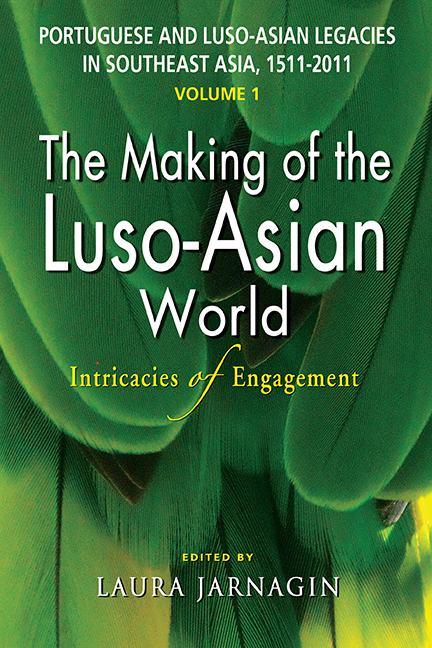 Portuguese and Luso-Asian Legacies in Southeast Asia, 1511–2011, vol. 1
Portuguese and Luso-Asian Legacies in Southeast Asia, 1511–2011, vol. 1 from Part Two - Dispersion, Mobility and Demography from the Sixteenth into the Twenty-first Centuries
Published online by Cambridge University Press: 21 October 2015
O papagaio do paco Nao falava — assobiava. Sabia bem que a verdade Nao e coisa de palavra. Fernando Pessoa
The parrot in the palace never spoke — whistled instead. It understood full well the truth's not something to be said.
The folksong “Papagaio Verde” (Green Parrot) is one of the oldest and most widely known Portuguese cantigas — stanzas of verse sung to traditional melodies — that spread from Indo-Portuguese communities to South and Southeast Asia. Sung from Diu to Macao, the papagaio verde is a popular and agile motif: it flies in from afar to teach maxims, play the rogue, criticize or insult, sing to a lover, or beat its wings and sing dance tunes. Variants of quatrains on the theme of the green parrot sung in Creole Portuguese have been collected throughout Luso-Asian communities by linguists, folklorists and ethnographers, and remain part of folk traditions performed in Daman, Malacca and Macao.
Parrots — birds of the order Psittaciformes found in Portugal and throughout the tropical and semi-tropical lands contacted by the Portuguese voyages — appear as a motif in early Portuguese folk verse and folksong. Popular seven-syllable quatrains or cantigas, collected in the field by ethnographer Jose Leite de Vasconcellos (1858–1941), invoke birds with green feathers, or green parrots, for their intelligence, playful social skills, ability to imitate the human voice and long, direct flight. In the nineteenth century, it was common to give a parrot as a gift. Brazilian statesman Joaquim Nabuco (1849–1910) favoured the English politician Charles Herbert Allen (1824–1904) with two parrots, and the recipient wrote in appreciation on 9 February 1900:
[Thank you] for so kindly bringing me another beautiful green parrot … You will be pleased to hear that the beautiful parrot has grown into a very fine bird and … is so active and lively. He still calls himself “papagaio real” but has already picked up many enough words and phrases. My two daughters are extremely devoted to him and he really comes out of the cage to sit on their hands. The grey African parrot looks on him with contempt … He is wonderfully imprudent.
To save this book to your Kindle, first ensure [email protected] is added to your Approved Personal Document E-mail List under your Personal Document Settings on the Manage Your Content and Devices page of your Amazon account. Then enter the ‘name’ part of your Kindle email address below. Find out more about saving to your Kindle.
Note you can select to save to either the @free.kindle.com or @kindle.com variations. ‘@free.kindle.com’ emails are free but can only be saved to your device when it is connected to wi-fi. ‘@kindle.com’ emails can be delivered even when you are not connected to wi-fi, but note that service fees apply.
Find out more about the Kindle Personal Document Service.
To save content items to your account, please confirm that you agree to abide by our usage policies. If this is the first time you use this feature, you will be asked to authorise Cambridge Core to connect with your account. Find out more about saving content to Dropbox.
To save content items to your account, please confirm that you agree to abide by our usage policies. If this is the first time you use this feature, you will be asked to authorise Cambridge Core to connect with your account. Find out more about saving content to Google Drive.